Day 2 of a 3-day Spring Migration tour in Norfolk. It was a grey morning with intermittent drizzle showers, drier in the afternoon but with an increasingly blustery wind, before the drizzle returned later in the day. Still, it was better than forecast with no sign of the heavy rain we were predicted, so it didn’t stop us getting out.
On our way to Titchwell this morning, we drove over via Choseley. There were still a few Linnets on the wires and a Yellowhammer flew up from the side of the road, so we stopped on the corner to see if we could find one in the hedge. We could see lots of Red-legged Partridges in the fields and a pair of Grey Partridge too, which ran out from the edge and out into the middle of the winter wheat. A couple of Chinese Water Deer were in the fields too. A succession of Mediterranean Gulls flew over calling.
A Yellowhammer flicked up into the top of the hedge but dropped down out of the back. From the road, we could see down along the edge of the field beyond and there we found a pair of Yellowhammers feeding in the furrows very close to us, nice views. Another smart male Yellowhammer was on the wires by the road and dropped down into the hedge below where a female appeared too and we saw them mating.
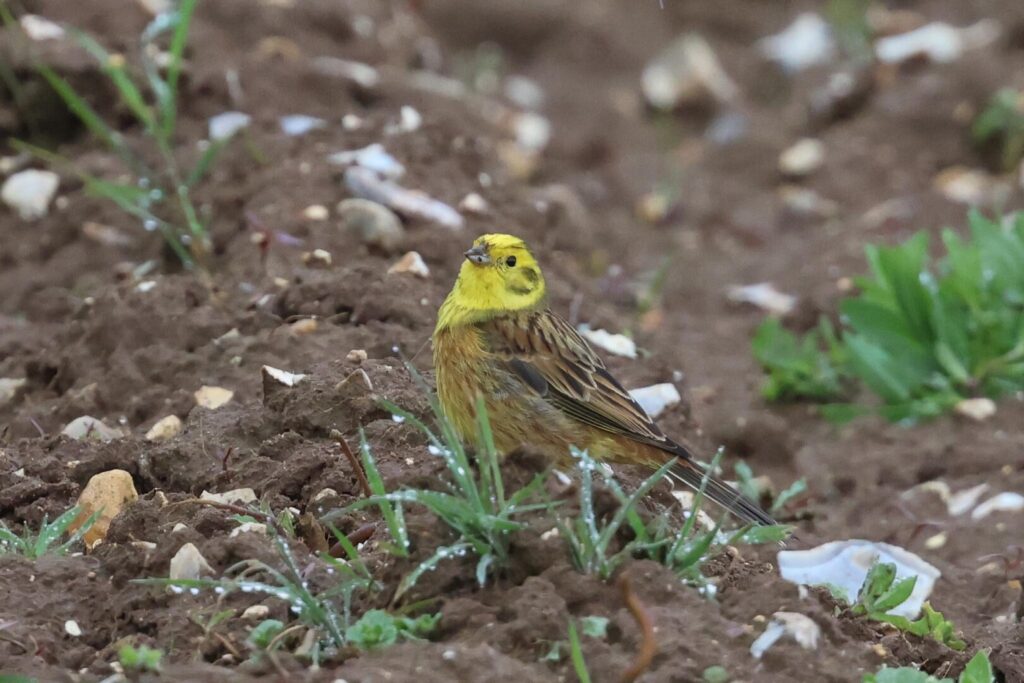
A Lesser Whitethroat was singing from the other side of the road further down and as we looked along the hedge we found it perched out in the open in the top. It had rained overnight and there was a bit of brightness now, so it was probably trying to warm up. It worked its way closer to us, singing and stopping to preen. Then a Common Whitethroat appeared in the top of the hedge even closer and started singing, a nice chance to compare the two.
We could have stayed here all morning, but we managed to tear ourselves away and continued on down to Titchwell. A Blackcap was singing in the trees in the car park as we got out and then a Willow Warbler started up too. There were not many cars here yet, so we decided to have a quick look around the overflow car park before it got busy. As we walked round, we heard a Cetti’s Warbler singing and saw it fly up into one of the apple trees. It perched in full view now, in amongst the pink apple blossom, and we could watch it singing. Always unusual to see one quite as well as this.
Scanning the paddocks at the far end of the car park from the gate, we found three Wheatears, two males and a female. They were perching on the fence posts, the stable roof and a nearby dung heap and kept dropping down into the grass by the horses. Then we noticed the Black Redstart, which had been here yesterday, flick up onto the fence just with them and we got it in the scope. It disappeared for a while, then reappeared doing a circuit of the fence posts, flying straight in and landing on the fence just across the track in front of us.
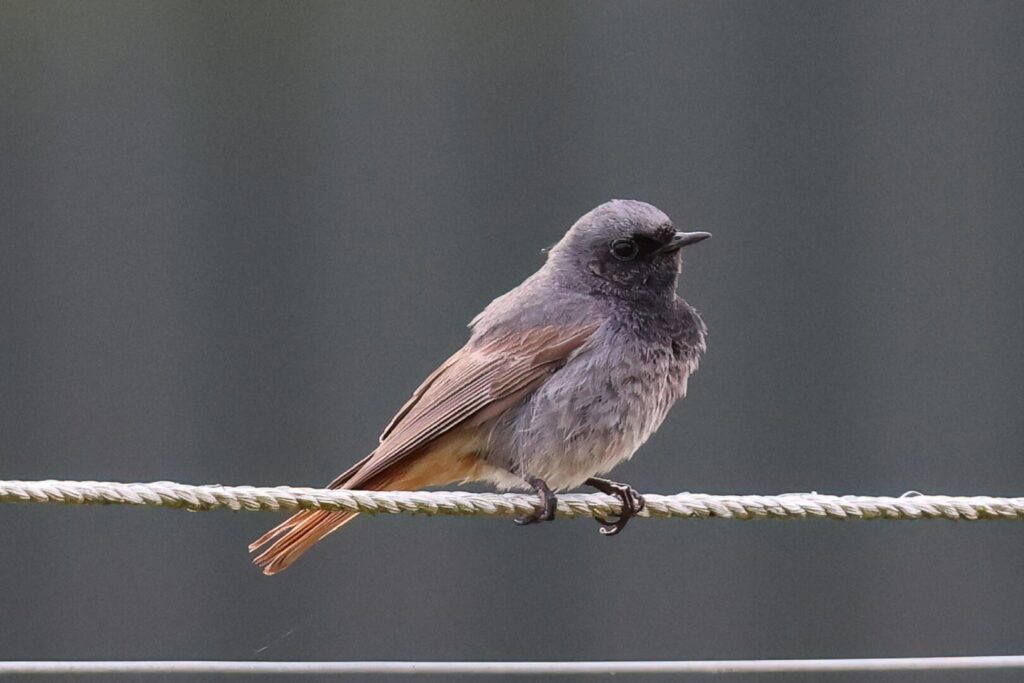
There were a couple of Pied Wagtails around the stables and then a Yellow Wagtail appeared in the grass nearby, a smart yellow male. It was then joined by a second male and we watched the two of them together before they suddenly took off and flew off west, presumably carrying on their journey. A really nice selection of migrants here this morning. A rather soggy looking Red Kite perched up in the dead trees beyond, preening.
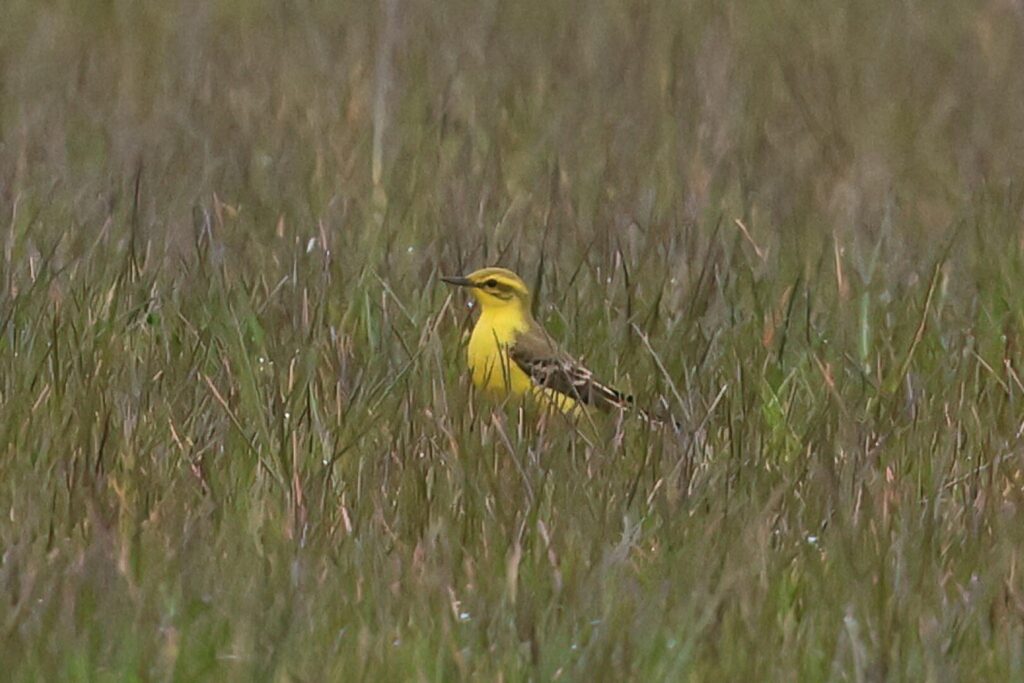
As we walked back through the car park, a Song Thrush was feeding on the edge of the gravel. Back by the minibus, the Willow Warbler was now singing in a willow right above us so we stopped to watch it.
Continuing out to the reserve, there was not much on the feeders behind the Visitor Centre, so we started to walk out on the main path. We scanned the hedge along the side of the Thornham grazing marsh and found a single male Stonechat distantly flitting up and down from the brambles and electric fence. While we were watching it, one of the group spotted an owl flying in over the grass from behind the trees – a Short-eared Owl!
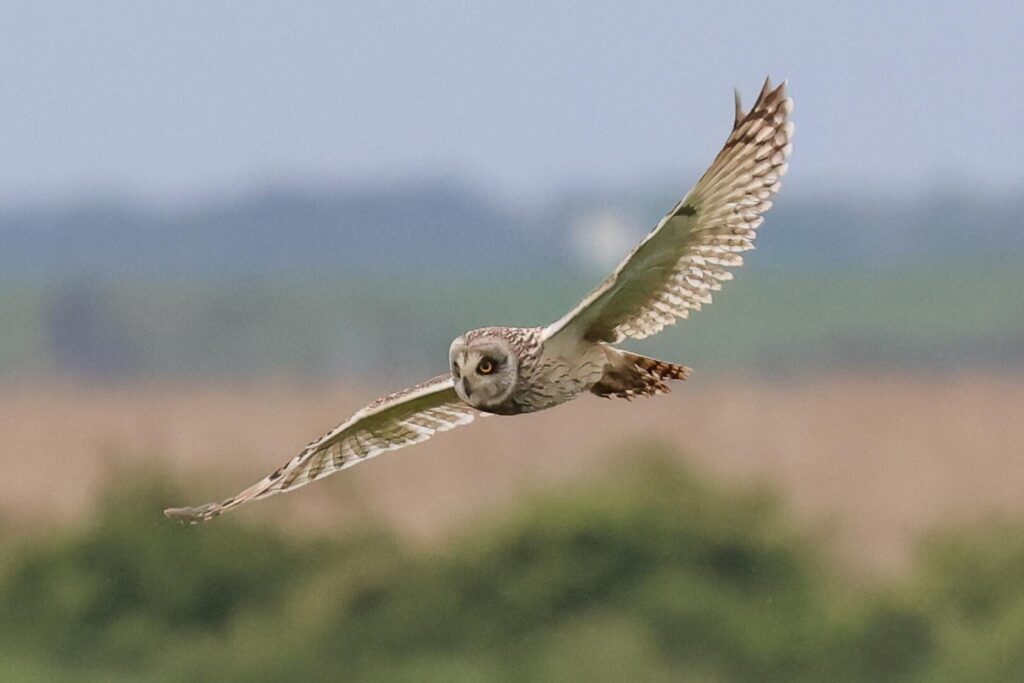
The Short-eared Owl put on a good display for us, hunting back and forth over the ground, dropping down a couple of times, landing on the fence, then doing another circuit. Eventually it was mobbed briefly by a passing Common Gull and flew over the hedge and landed in the furrows in the field the other side.
We could see some people photographing something on the borrow pits, which normally means Bearded Tits, so we walked up to see what was there. It turned out not to be Bearded Tits, but some goslings, not what we were hoping to find! A couple of Sedge Warblers were singing and songflighting.
Then we noticed a different bird flying in over the reeds and as it dropped into one of the sallows we got a flash of an orange-red tail. A female Common Redstart, a spring migrant just arriving and dropping in, in front of our eyes. Unfortunately, it quickly dropped down through the branches and disappeared and we couldn’t find it again.
It started to spit with drizzle now and we could see threatening grey clouds approaching from the west, so we hurried on to Island Hide as it began to rain a bit heavier. There were mostly Black-headed Gulls here, they have taken over all the new islands to breed, with a few Avocets feeding in the deep water. Looking through the gulls, we found a single Common Tern huddled down on one of the islands, a freshly returned summer visitor and our first of the year here.
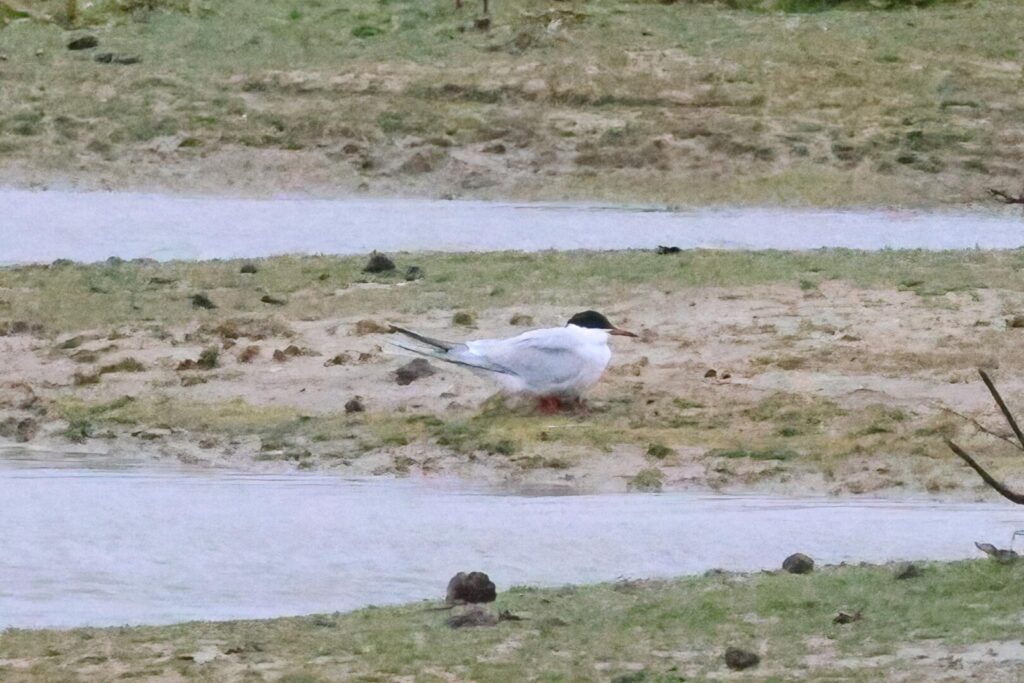
There were not many other waders on here – there isn’t much open mud at the moment. We did manage to pick up a single Turnstone with two Dunlin right over the back briefly. A female Bearded Tit was working its way low down along the edge of the reeds the other side of the hide. It flew off with a bill full of insects, presumably to feed its young in the nest somewhere in the reedbed. It flew back in a couple of times but mostly fed deeper in the reeds today, and we had brief views of a couple of male Bearded Tits flying in and out too.
There were a few Swallows and House Martins on the move this morning, some pausing to feed over the Freshmarsh or the reedbed pool beyond. A Common Swift flew in too and did a quick couple of circuits over the water before continuing its way west. Nice to see some spring migration in action today.
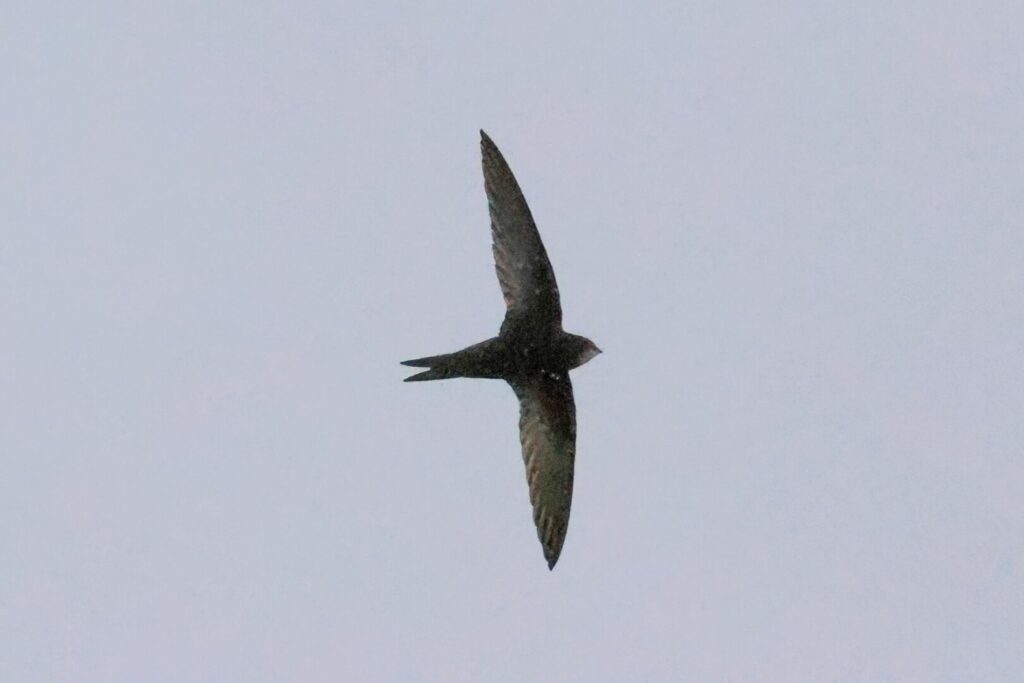
The rain had eased so we took advantage and walked round to Parrinder Hide. We eventually managed to find a single Mediterranean Gull on one of the islands with the Black-headed Gulls but there weren’t many here today. The Dunlin had disappeared, presumably flown on, but there were a few more Turnstones on the islands here now, probably pushed off the beach by the high tide this morning. A single female Ruff dropped in on the short grass from the other side of the hide.
The rain had stopped, so we decided to make a quick bid for the beach. The wind had picked up significantly so it was rather blustery back out on the main path. We stopped in the lee of the bank and had a quick look at the muddy channel on the far side of the Volunteer Marsh, finding several Grey Plovers, one already in full breeding plumage with black face and belly, and a single Curlew. There were a few Black-tailed Godwits and a single Ringed Plover on the islands on the Tidal Pool.
We managed to find a little bit of shelter in the dunes to have a quick look out at the sea. A small raft of about a dozen Common Scoter were riding the swell just offshore. Some little groups of Sanderling were running in and out of the waves on the beach and a couple of Bar-tailed Godwits were feeding in the breakers. Nothing was moving offshore but we could just make out the Sandwich Tern colony on Scolt Head away to the east.
Walking back quickly in the wind, we stopped briefly to scan the Freshmarsh where a single Knot had dropped in amongst the gulls and four Common Terns were now on one of the islands. More hirundines were hawking low over the reedbed pool, a single Sand Martin in with them. It was more sheltered when we got back to the trees and we looked up to see shree more Common Swifts flying over, heading on west.
We cut in along Meadow Trail now. A Reed Warbler was singing from the sallows on the edge of the dragonfly pool. A Blackcap shot across as we got to the tank road. We had a quick look at Patsy’s Reedbed but there were not many birds on the water – just a few Common Pochard, Tufted Duck and Coot. A couple of male Marsh Harriers came up from time to time out of the reeds beyond. Another Common Swift flew through but the passage of hirundines seemed to have dried up a little.
It was time for lunch, so we headed back to the Visitor Centre to get a welcome hot drink. Afterwards, we drove back east. We stopped briefly at Brancaster Staithe but there weren’t many waders in the harbour now – a single Grey Plover and a single Ringed Plover.
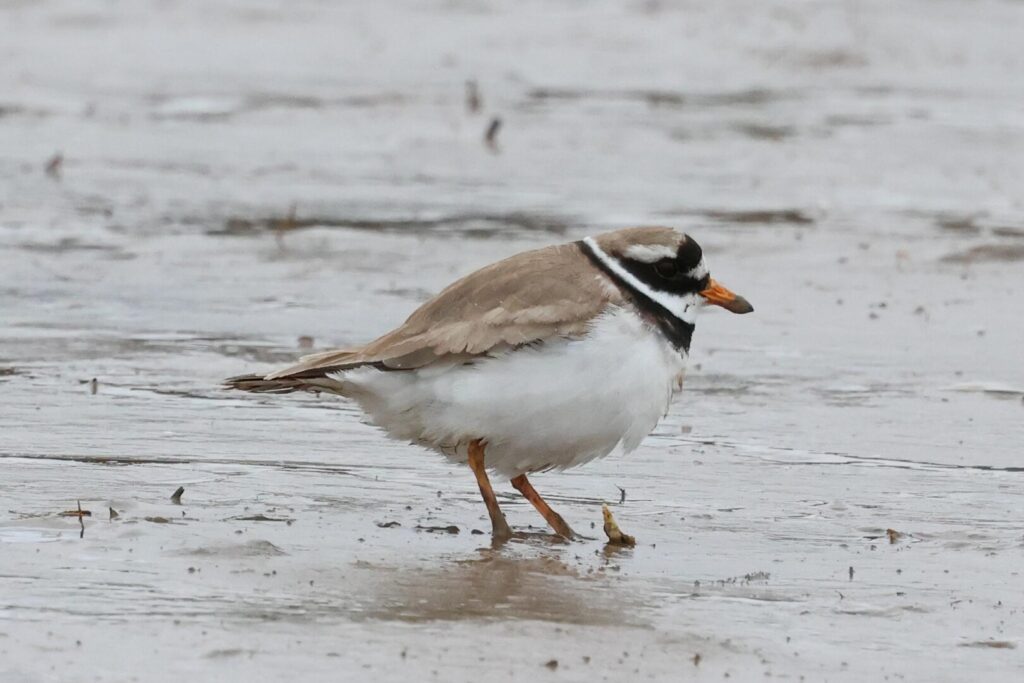
Our destination for the rest of the afternoon was Holkham. As we got out on Lady Anne’s Drive it was very blustery still and hard to hold our binoculars still. A large group of Black-tailed Godwits were feeding on the wet grass just to the west, mostly now in bright rusty breeding plumage. There were six feral Barnacle Geese with the Greylags, and a single hybrid with them, presumably a Barnacle x Ross’s Goose.
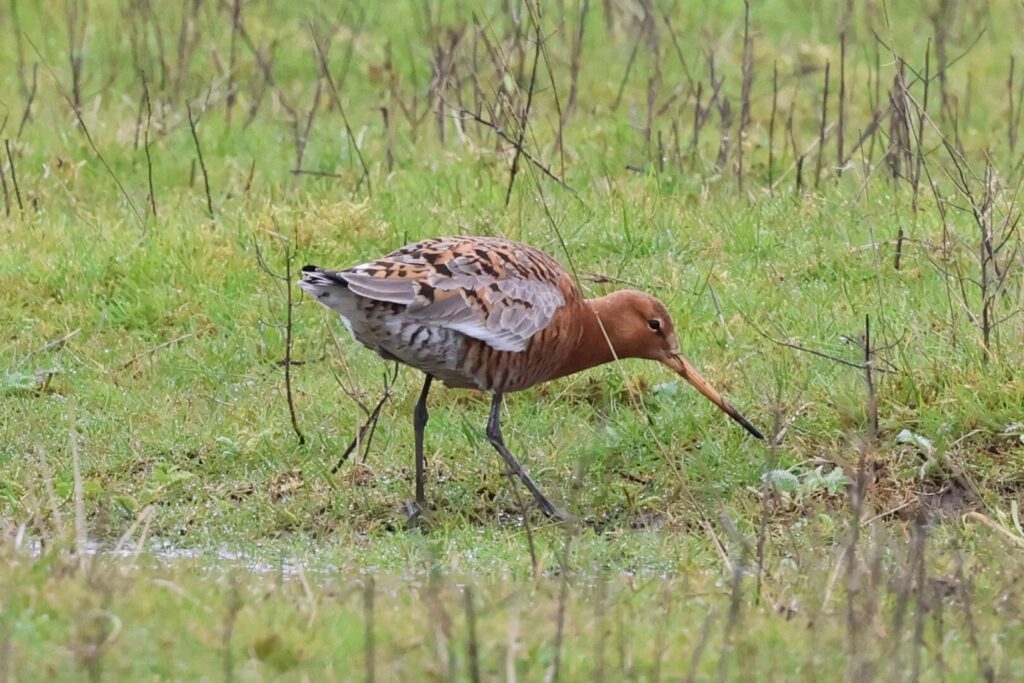
It was a bit more sheltered up by the pines, and from here we got the scope on the pair of Ring Ouzels which have been lingering here for the past few days. They were feeding on the grass at the base of the brambles behind the godwits and geese, nice to see a male and female alongside each other in the open.
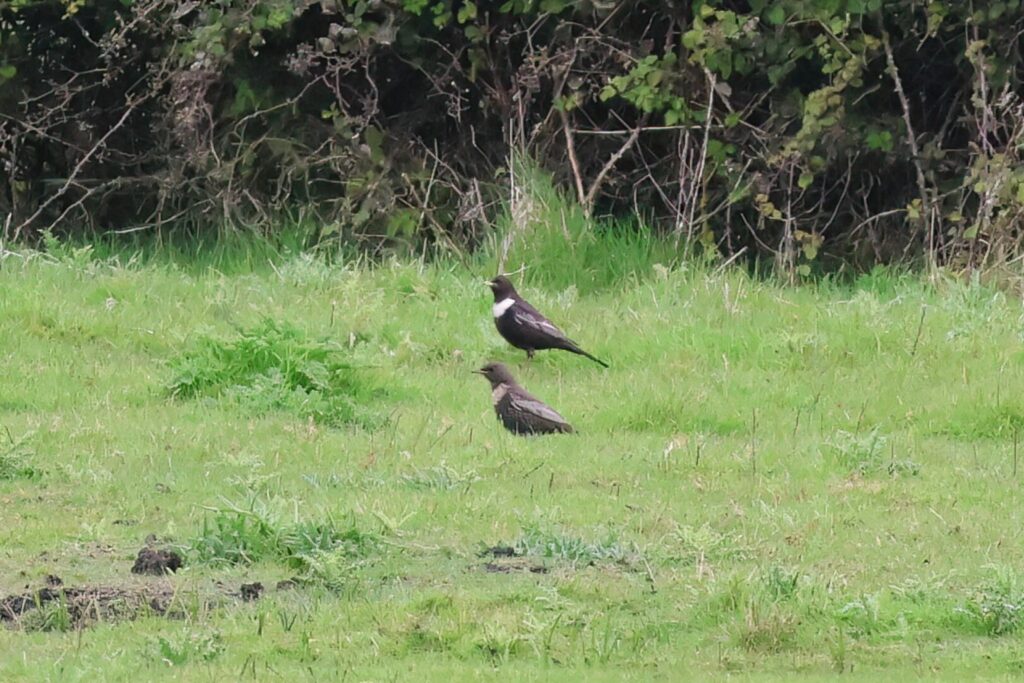
A Willow Warbler was singing in the trees as we walked west along the track. We stopped to look at three Long-tailed Tits and two Blackcaps were singing above us, both presumably trying to attract the female which was nearby. A Chiffchaff flitted around the branches too.
There was very little on Salts Hole now, just a pair of Tufted Ducks, but just beyond we stopped to watch a Treecreeper on a big old holm oak. It kept flying down to the base and following a different trunk up. More hirundines were flying over, following the edge of the pines west, along with three or four more Swifts – it was a good day for hirundines and Swift passage today.
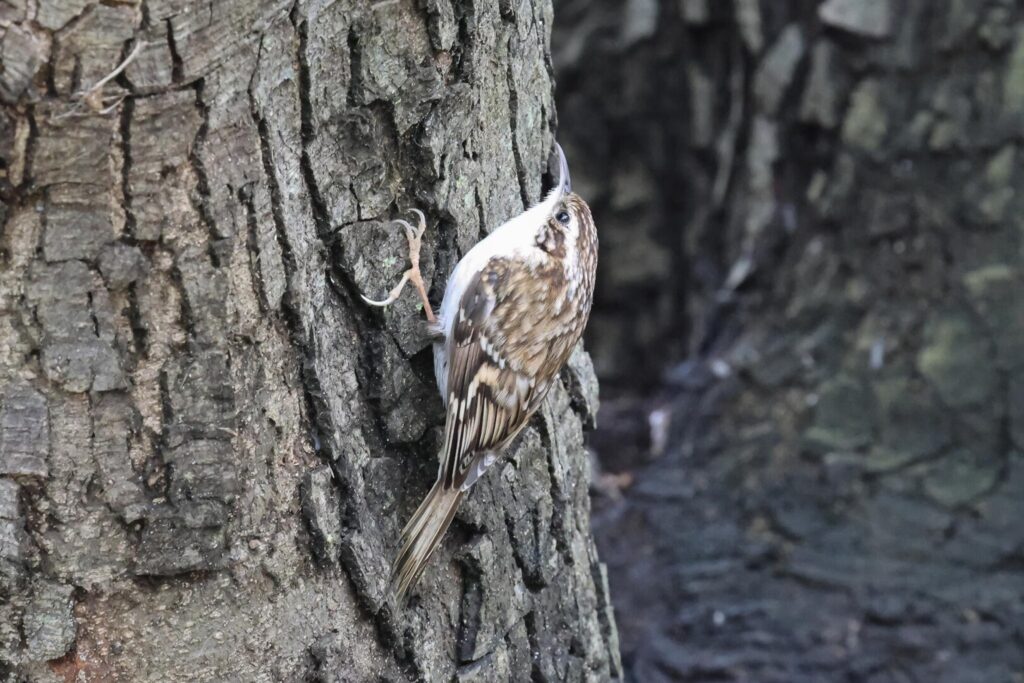
A quick scan from the gate before Washington Hide produced a couple of Grey Herons and a Spoonbill flying past, From up in the hide, we then found the Spoonbill out on one of the pools. It had a quick bathe and a preen before continuing on towards the breeding colony. Several more Spoonbills flew straight through, east and west. A pair of Marsh Harriers came up out of the reeds and there were a few Red Kites and Common Buzzards distantly over the Park beyond.
We walked down to the far end of the boardwalk to scan the sea. There were lots of Common Scoter just beyond the Little Tern colony and looking through carefully we found a single Velvet Scoter closer in. We could see the white wing patch from time to time as it dived just off the beach, although it took a bit of time before everyone managed to get a good look at it through the scope.
After everyone had managed a good look at the Velvet Scoter, we continued on west to the site of the old Joe Jordan Hide, where we were pleased to find that the base for the new hide has just been laid. There was no sign of any Great White Egrets thought from here today and no Spoonbills down around the pools, although more Spoonbills were flying in and out of the trees. Without anywhere to sit down at the moment, and with the cloud thickening again, we didn’t stay too long here and turned to head back.
As we got back to Lady Anne’s Drive, a Spoonbill was feeding on one of the pools east of the road so we got the scope on it. Much better views now, we could see its shaggy nuchal crest and the yellow tip to its bill. As we walked back to the minibus, a Great White Egret flew in and landed out of view the other side.
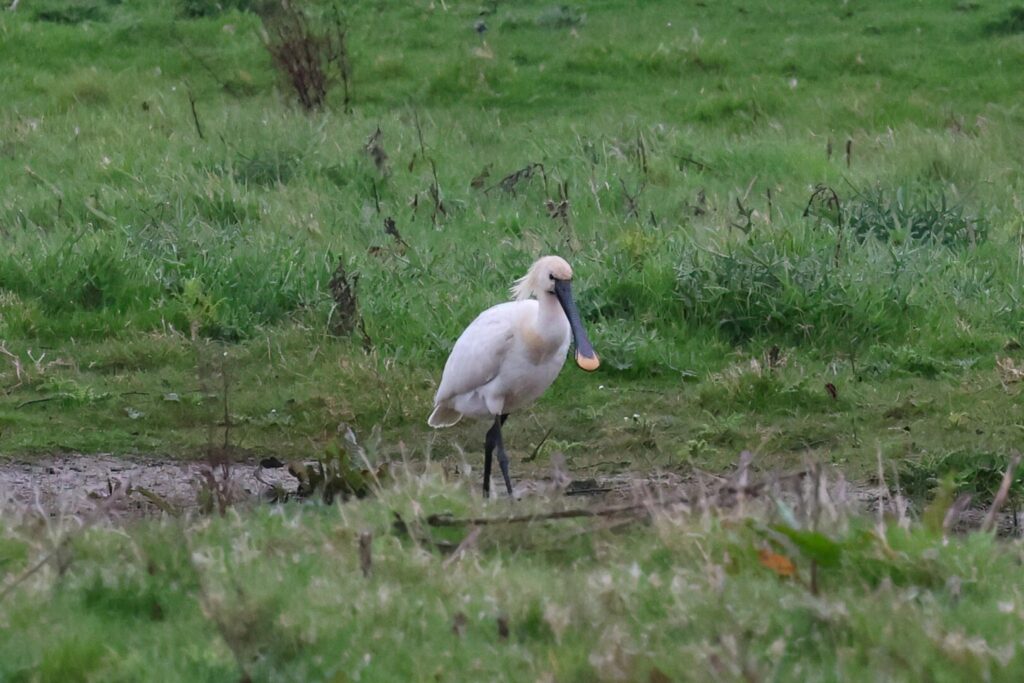
It was starting to spit with drizzle again but thankfully it was time to head back anyway. It was nice to see some spring migration happening today, and with better weather forecast and a change to a warm southerly breeze, we had another day ahead of us tomorrow.
















